Add a pop of bright color to your garden by planting stunning perennials that bloom in shades of orange. These vibrant flowers will transform your outdoor space into a lively and colorful festival. Whether you choose light-orange or peachy-orange blooms, they are sure to stand out and make a statement in your garden. Embrace the warmth and cheerfulness that orange flowers bring to your landscape.
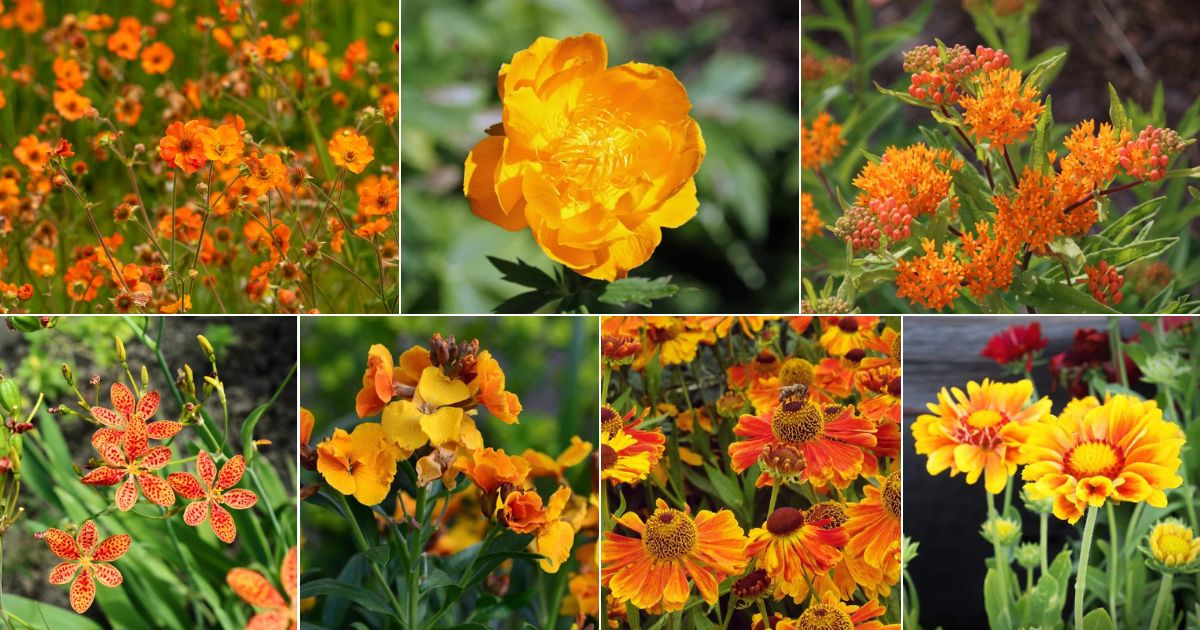
What Significance Does Orange Have in the Garden?
In the garden, orange is a color that evokes joy, warmth, and vitality. It is a cheerful and energetic color that can lift the spirits of anyone who lays eyes on it. Orange flowers are also associated with adventure, living life to the fullest, and daring creativity. If you want to add vibrancy and enthusiasm to your home, including orange flowers in your landscape is a great way to do it.
However, since orange flowers are so bold and attention-grabbing, they can be overpowering if not used judiciously. It’s essential to use orange flowers sparingly, so they don’t overshadow other colors or become the only thing you see. Additionally, many pollinators are attracted to brightly colored flowers, so including some brilliantly colored perennials in your garden is necessary.
If you’re planning to grow orange flowers, here are some tips to keep in mind:
– Plant orange bloomers sparingly around other flowers to avoid overshadowing them.
– Scatter orange flowers throughout the landscape instead of planting them in large groupings.
– Consider using orange flowers as a bright backdrop for less showy flowers.
– Experiment with different shades of orange to find the right one for your garden.
Some of the best-performing orange perennials include Orange Princess Globeflower, Blanket Flower, Butterfly Weed, Torch Lily, Rock Rose, Geum, Oriental Poppy, Wallflower, Turk’s Cap Lily, Falling Stars, Blackberry Lily, Tickseed, and Sneezeweed.
In summary, including orange flowers in your garden can bring a tropical vibe and a sense of adventure and creativity. With proper use and placement, orange flowers can make a beautiful addition to any landscape.
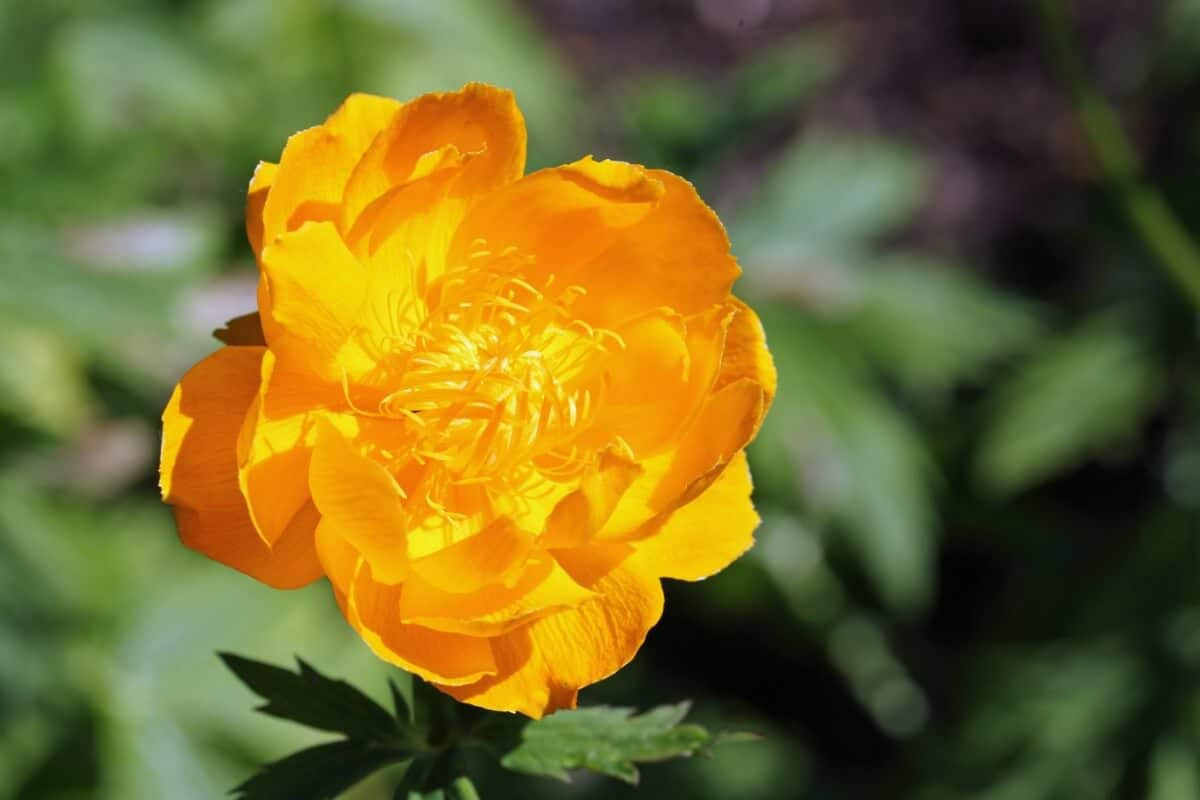
If you’re looking for a stunning orange flower that requires little attention, then Globeflowers are the perfect choice. These vibrant flowers have a beautiful golden-orange hue that illuminates any garden from late spring to early summer. Their bowl-shaped blooms resemble double buttercups and stand tall on sturdy stalks. Whether planted along borders or in large groupings, Globeflowers add an elegant touch to any landscape. Plus, they are incredibly easy to care for, thriving best in moist, boggy soil. Hardy to zones 3-8, these flowers prefer full sun or partial shade and are resistant to rabbits and deer. Another great option for an attractive orange perennial is the Blanket Flower (Gaillardia).
The Blanket Flower is a highly productive plant that blooms from early summer until the fall season. It’s an excellent choice if you’re looking for an abundance of brightly colored flowers to enhance your garden. The Daisy-like flowers resemble pinwheels with their sharp petals and tricolor markings, delivering a festive and fun vibe that butterflies and hummingbirds adore. The Blanket Flower rarely disappoints, providing a continuous bloom throughout the season. Orange-flowered Blanket Flower cultivars, such as Fanfare Blaze (orange-red) and Oranges and Lemons (soft orange), are hardy in zones 5-10 and are drought-resistant and deer-resistant. Another great option for your garden is Butterfly Weed (Asclepias tuberosa).
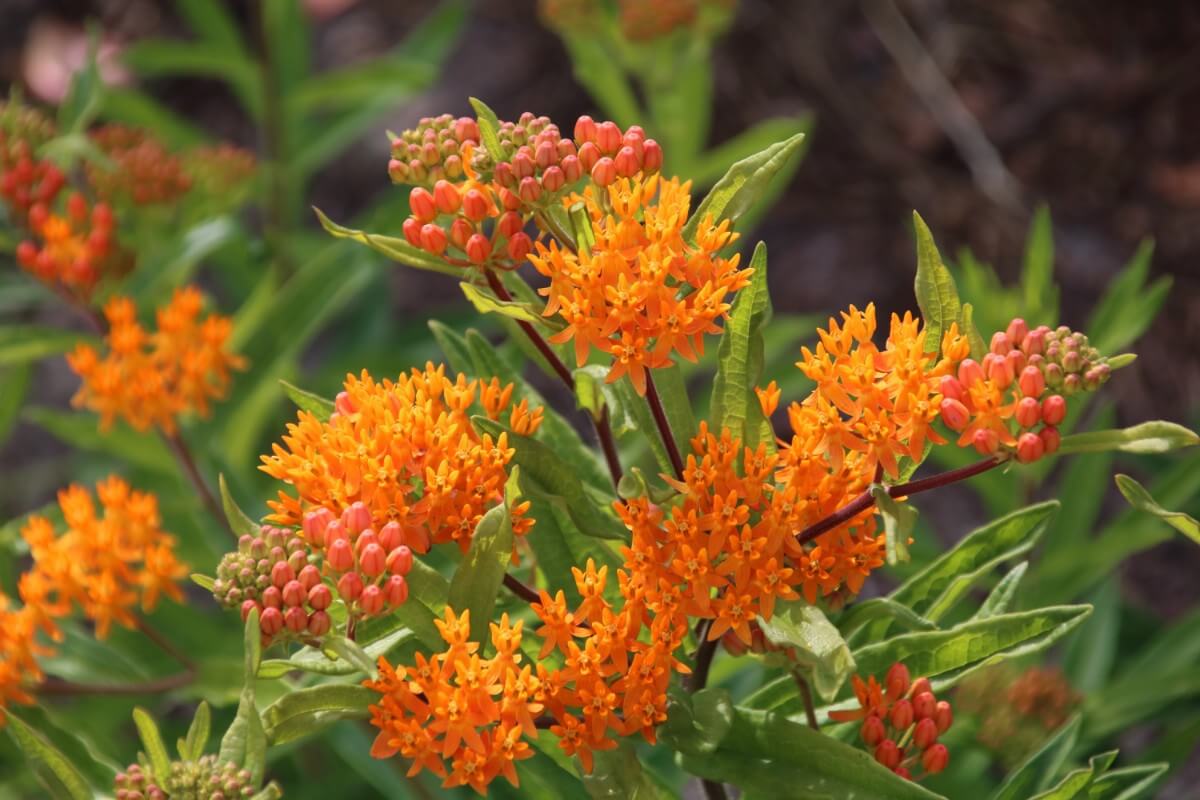
If you’re a fan of observing bees, butterflies, or hummingbirds, then you should definitely consider adding Butterfly Weed (also known as Butterfly Bush) to your garden. This perennial plant boasts stunning orange blossoms and rightfully earns its name with the constant visits from butterflies it attracts. The small, fiery orange flowers are densely packed and bloom all throughout the summer season. Whether you have a wildflower garden, butterfly garden, or simply want an eye-catching accent plant, Butterfly Weed is a perfect choice. Not only does it attract butterflies, but also bees and hummingbirds. Additionally, it’s a hardy plant that can thrive in zones 3-9 with full sun exposure, while also being deer resistant. This native plant can be found in most areas of the United States. Aside from Butterfly Weed, another gorgeous option to consider is Torch Lily (Kniphofia).
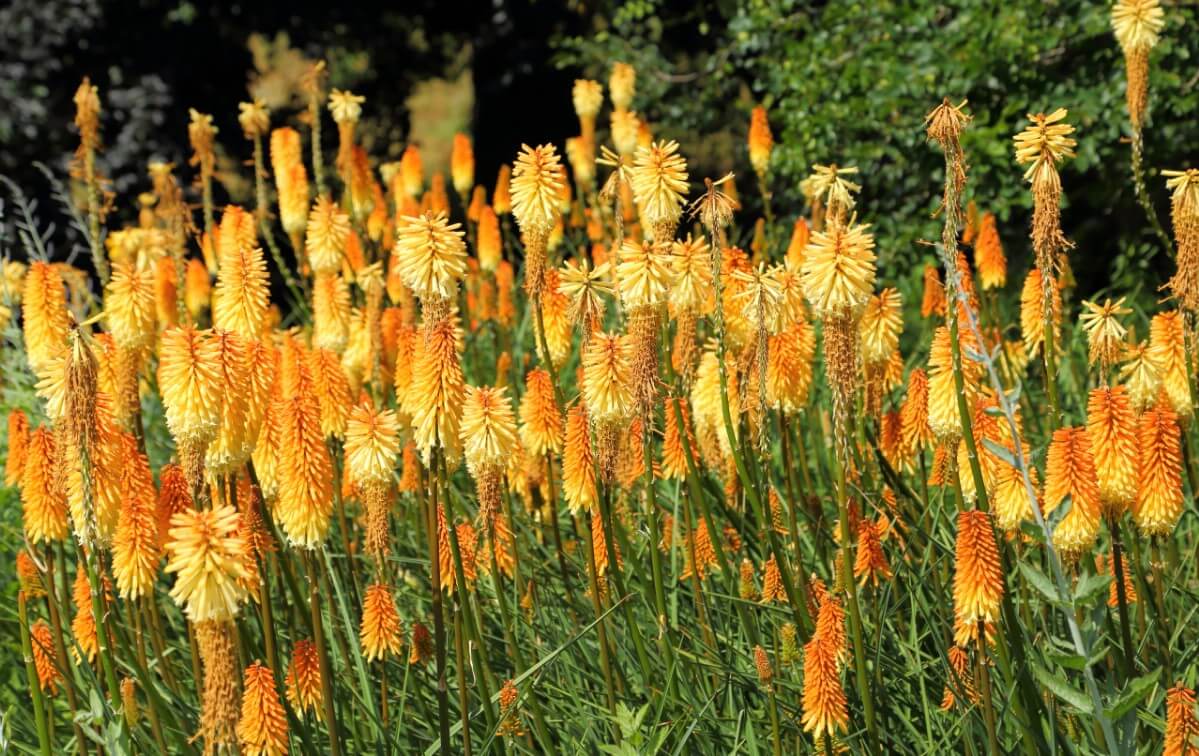
Torch Lilies are a remarkable and distinct addition to any floral arrangement. These gorgeous flowers feature dense clusters of vibrant orange blooms that sit atop tall, spiky stems. Their color gradually changes as they mature, giving them a stunning bi-color appearance that’s hard to miss. Torch Lilies blossom from late spring to early fall, making them a perfect choice for a summer display. Not only are these flowers beautiful, but butterflies and hummingbirds are also drawn to them. With a variety of heights ranging from 18 inches to 6 feet, Torch Lilies offer a range of options for your garden. Some popular orange cultivars include Alcazar, Elvira, Nobilis, Timothy, Poco Orange, Orange Blaze, and Papaya Popsicle. Torch Lilies are also incredibly resilient, able to survive in drought conditions, and are tolerant of deer and rabbits. Make sure to plant your Torch Lilies in full sun and in hardiness zones 5-9.
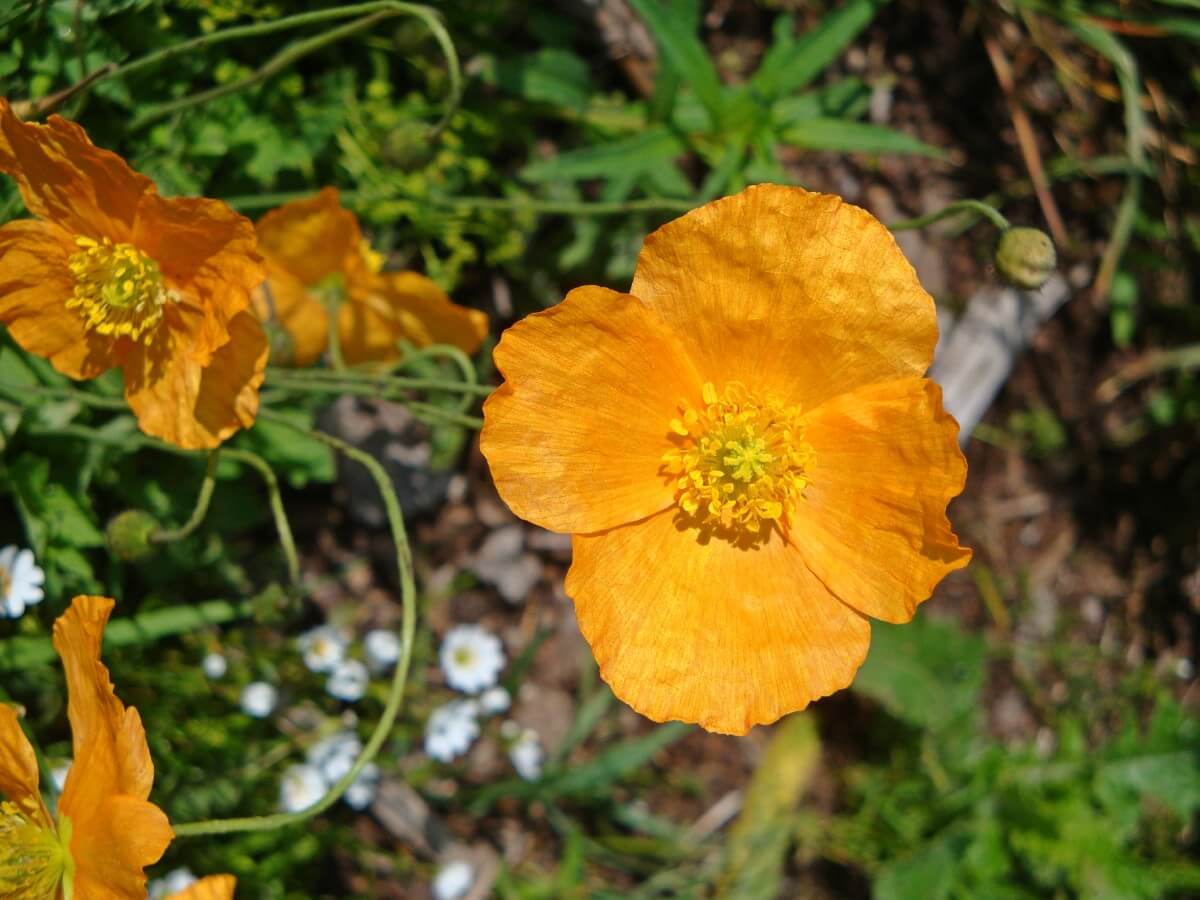
Looking for a vibrant orange ground cover that will bloom and thrive for months? Look no further than the Rock Rose! With its stunning rose-shaped flowers featuring crepe paper-like petals and a shiny orange hue, the Rock Rose is both elegant and captivating. And with abundant blooms that last for a day each, but are constantly replaced by new buds, you’ll enjoy a colorful display all season long. As a low-growing perennial averaging just 6-8 inches tall, Rock Rose foliage is also an attractive silvery green that makes for a great ground cover. Consider Orange-flowered Rock Rose cultivars like Henfield Brilliant (bright tangerine orange) or Ben Nevis (golden orange). This hardy plant is suited for full sun, and is both rabbit and deer resistant as well as drought tolerant. If you’re searching for another option, consider the Geum (Avens) for a similarly stunning orange ground cover.
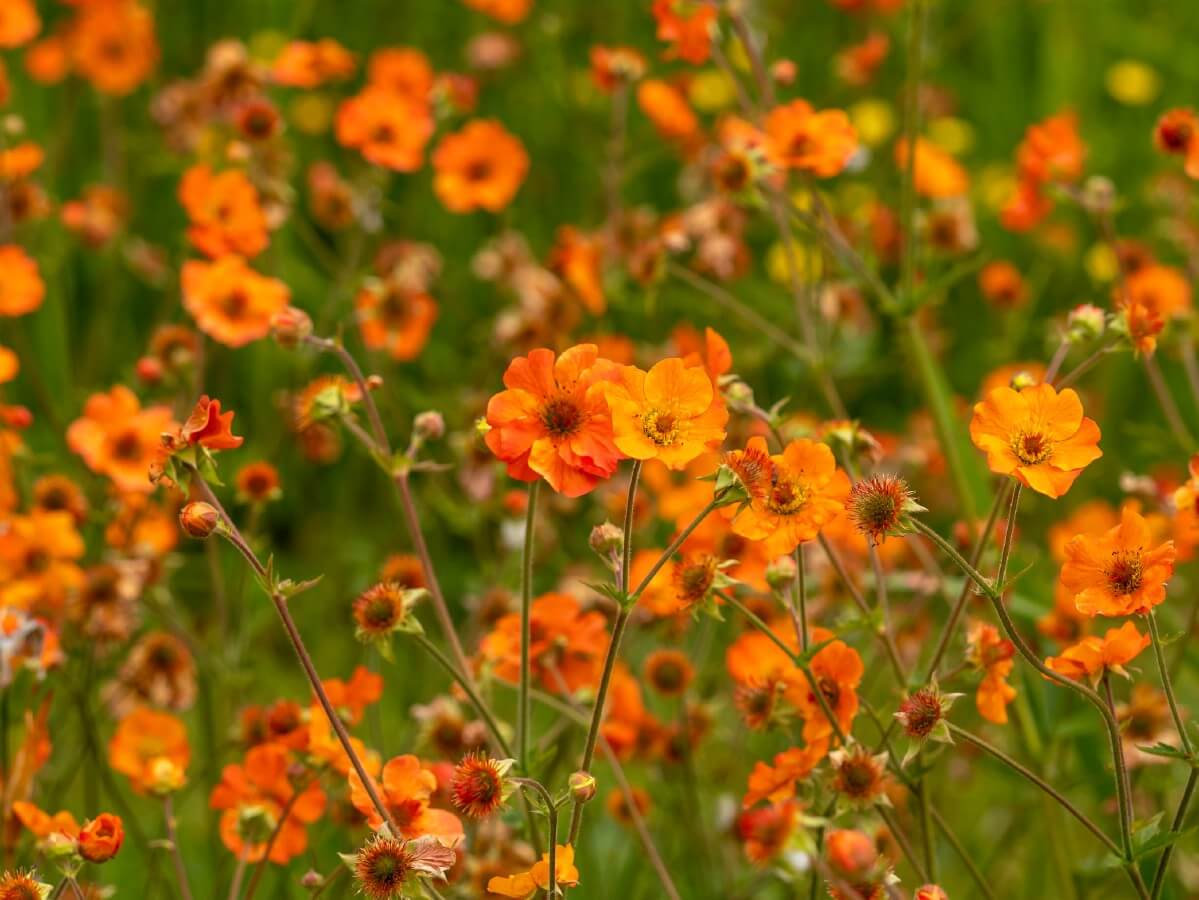
Geum, with its long-lasting blooms, is a perfect addition to any walkway or path. Not only does it add charm and enchantment to your garden, but it also attracts butterflies and hummingbirds, making it even more lively. This perennial is clump-forming and produces an abundance of peach-colored flowers on tall, branched stems. You can easily plant it in clumps, along pathways, or in rock gardens as it requires low-maintenance and adapts well to any environment. The upward-facing cup blooms are irresistible to bees, butterflies, and hummingbirds, and the plant blooms for a long time, providing bold color from late spring to early summer. You can choose from different orange-flowered Geum cultivars, such as Prinses Juliana, Borisii, Fireball, Fire Storm, and Totally Tangerine. Geum is hardy to zones 5-9 and thrives in full sun or partial shade, and it is resistant to rabbits and deer. Another great addition to your garden is the Oriental Poppy (Papaver orientale).
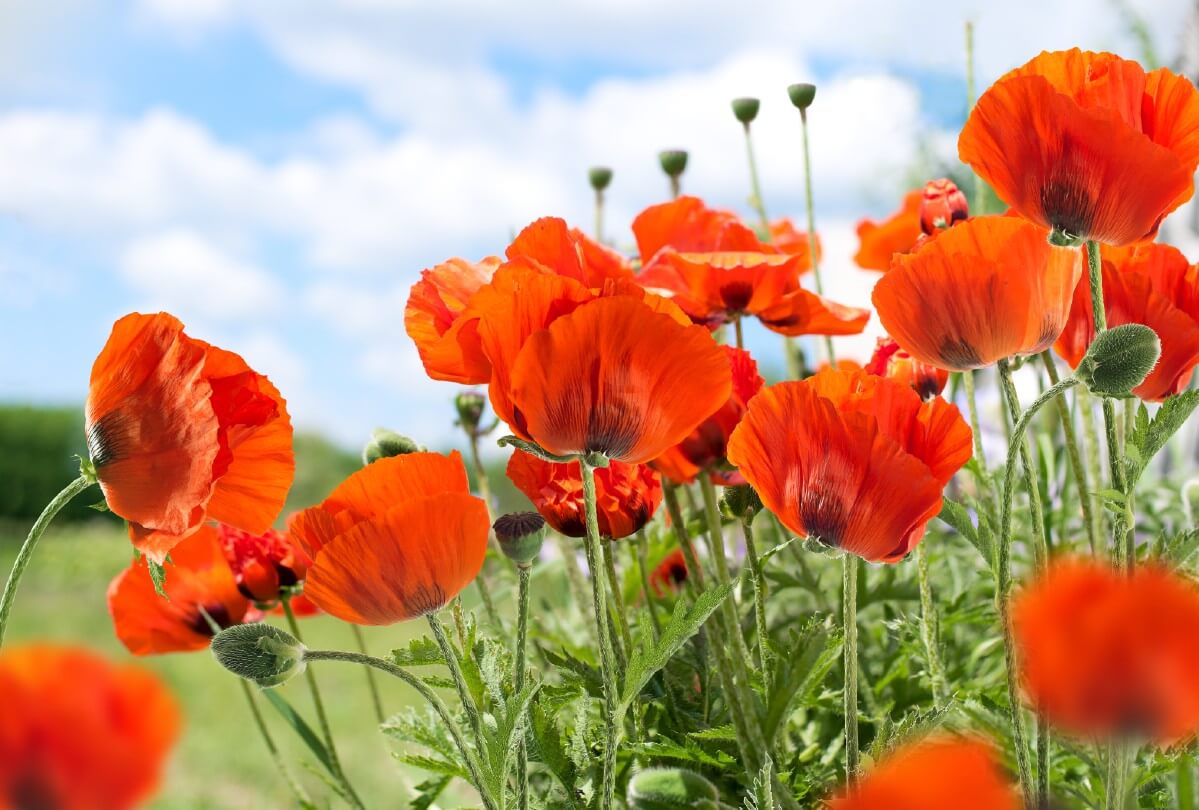
Who doesn’t appreciate the beautiful extravagance of Oriental Poppies? These impressive flowers possess a vast, smooth, crepe-paper-like blossom that attracts not only people but also pollinators. Oriental Poppy blooms have an exotic appearance that showcases their exquisite beauty and long blooming period. There are numerous cultivars of this flower with various color combinations, including some incredibly stunning orange shades. Additionally, even after the blooming season, the seedpods of these flowers continue to enthrall. Once grown, Oriental Poppies are effortless to care for and require minimal maintenance.
Some of the notable orange-flowered Oriental Poppy cultivars available include Eye Catcher (bright orange-red), Fireball (semi-double, bright orange), Prince of Orange (bright tangerine), Orange Scarlet (orange-red), and Orange Glow (deep orange). These flowers are deer and rabbit resistant and thrive in full sun, suitable for hardiness zones 3-7. When it comes to adding more charm to your garden, these flowers are an excellent choice.
Apart from Oriental Poppies, another plant that can bring your garden to life is Erysimum or Wallflower.
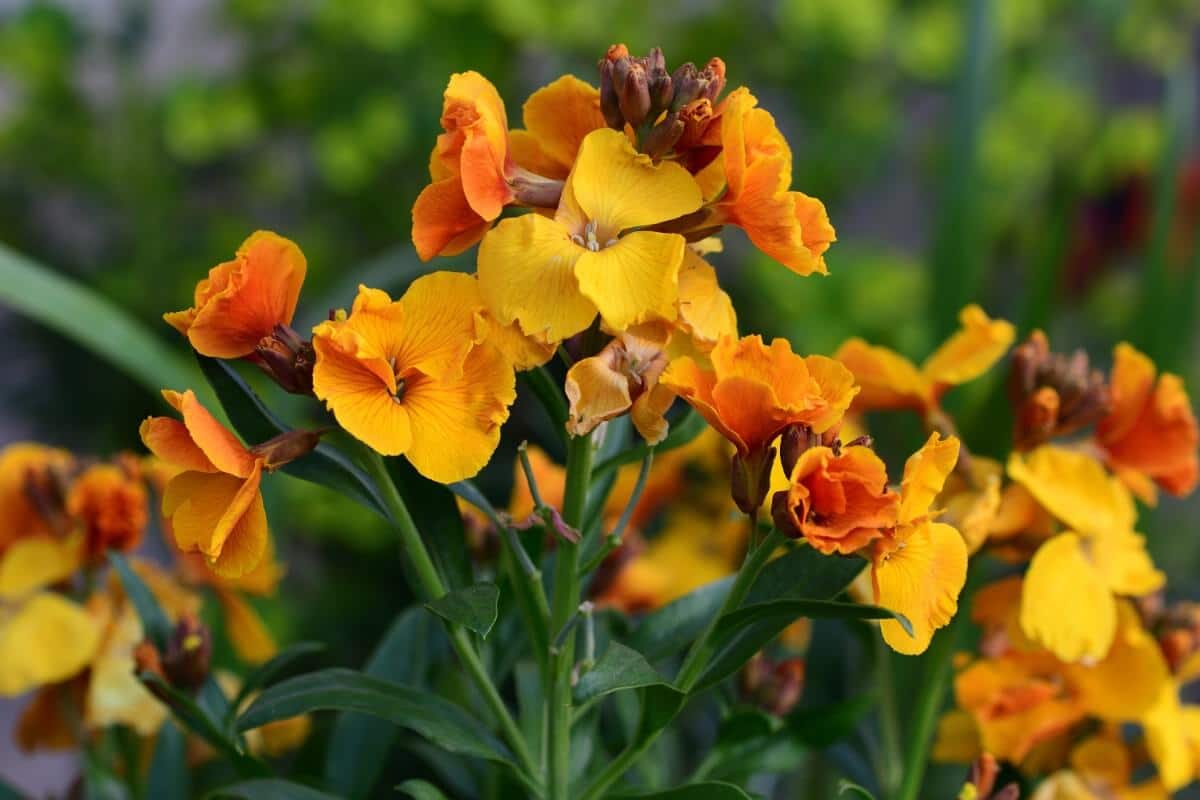
Have you ever wondered why Wallflowers are called as such? Contrary to what their name suggests, these short and compact plants are anything but unassuming. With their sweet-scented orange flowers and dark green evergreen foliage, they put on an impressive display when in full bloom from mid-spring through summer. Wallflowers are not only beautiful but also versatile, making them easy to grow and perfect for cascading down walls or fences. They are also among the first spring bloomers, alongside daffodils and crocus, providing a much-needed burst of color after a long winter. Interestingly, Wallflowers get their name from their persistent nature of sprouting through cracks in cement and brick walls. Some popular orange-flowered Wallflower cultivars include Apricot Twist, Walberton’s Fragrant Sunshine, Orange Bedder, and Fire King. These perennials are hardy to zones 6-9, thrive in full sun, and are deer-resistant. Another stunning spring bloomer is the Turk’s Cap Lily, scientifically known as Lilium superbum.
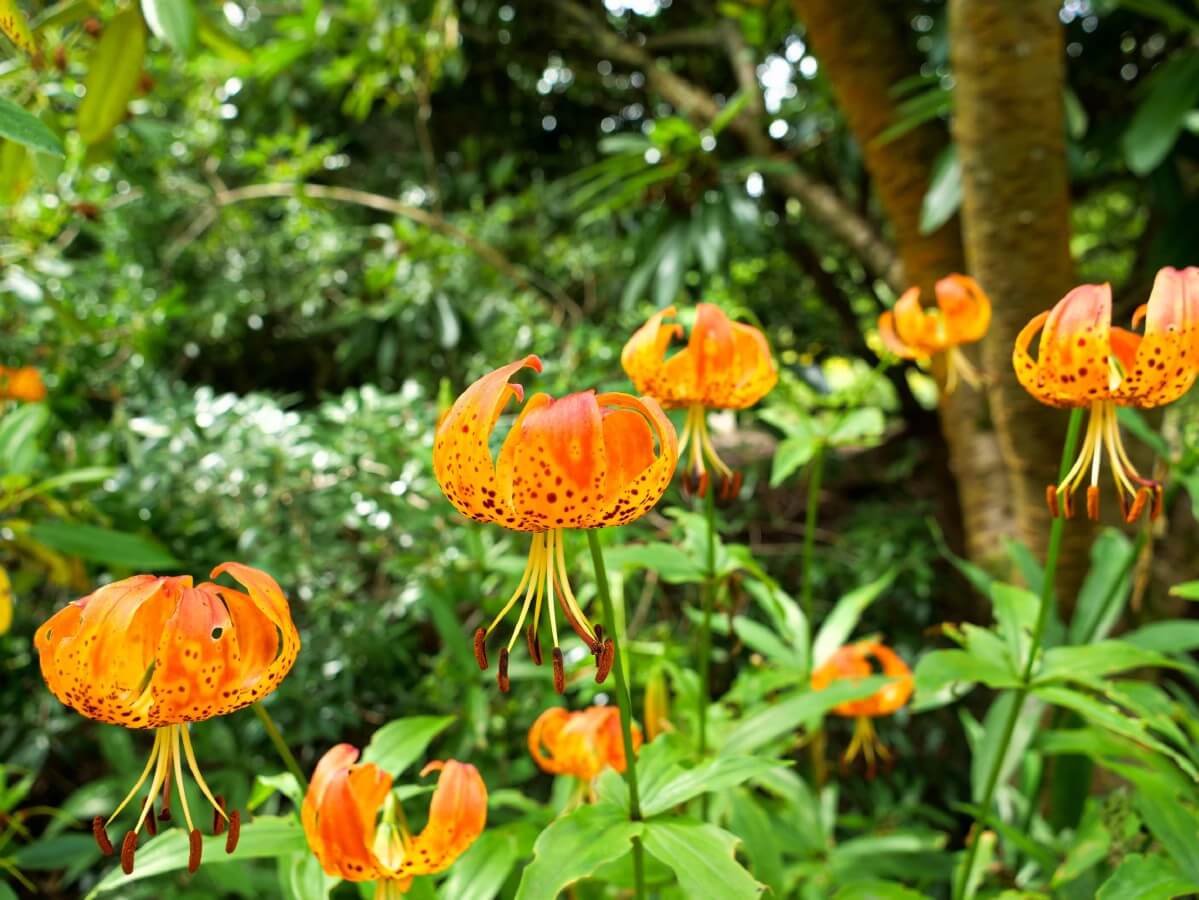
The Turk’s Cap Lily is a captivating wildflower due to its distinct shape and posture. During the summer season, this native flower puts on a breathtaking show with an abundance of bright tangerine-orange blooms, adorned with maroon freckles atop tall stems. The petals of the Turk’s Cap Lily gracefully curl upwards, while the crimson red stamens stretch downwards, creating an exotic and visually stunning effect. Moreover, this flower tends to grow in clusters, which are often visited by hummingbirds and butterflies. It thrives in zones 4-7, requires full sun or partial shade, and is indigenous to the eastern region of the United States. Another noteworthy wildflower is the Falling Stars (Crocosmia).
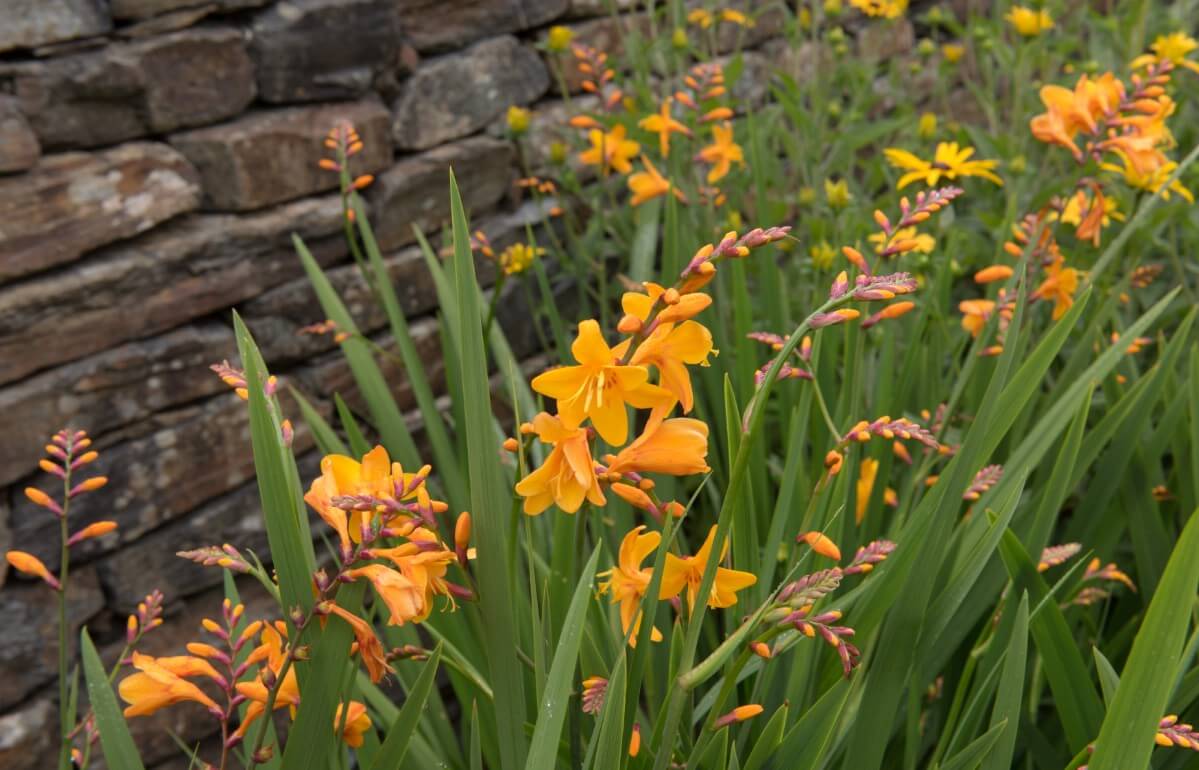
Crocosmia flowers have striking stalks, making them a great choice for any garden. They also make wonderful cut flowers. Falling Stars flowers, in particular, are a beautiful exotic bloom that adds a pop of color to any garden. Their deep green foliage forms dense clumps, with sword-shaped leaves, and the flower stalks arch above it in a long-drooping array. Each stem is lined with a dozen rich orange tubular flowers, creating a stunning contrast against the green foliage. Hummingbirds are particularly drawn to this perennial. There are several orange-flowered Falling Stars cultivars, including Bright Eyes, Meteore, Emily McKenzie, and Star of the East. This plant is hardy in zones 5-9 and thrives in full sun or partial shade. It is also drought, salt, heat, and humidity tolerant, as well as deer and rabbit resistant. Another great option for a unique garden is the Blackberry Lily, also known as Iris domestica.
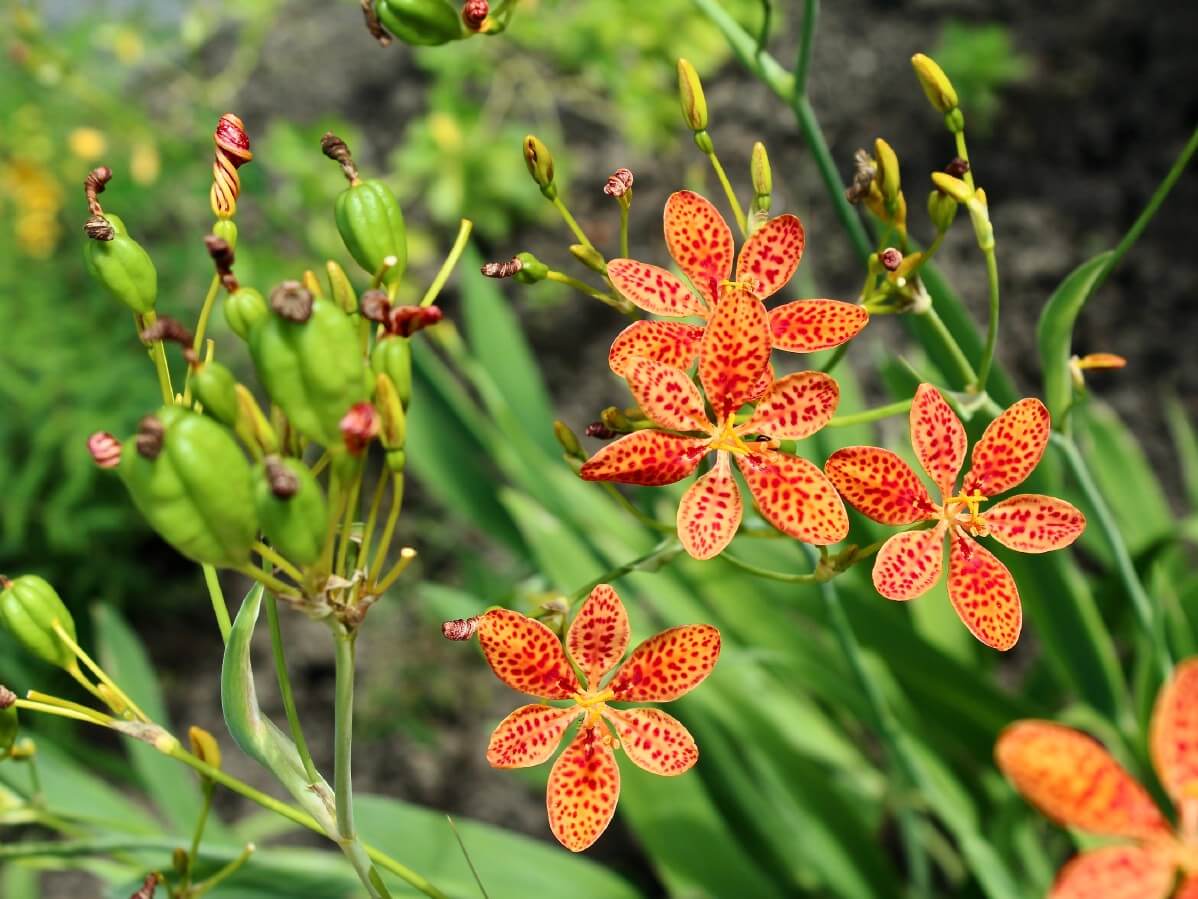
Don’t you think that the Blackberry Lily has a unique flower and petal design that sets it apart from most other flowers? The striking upward-facing orange freckled flowers make for an exceptional centerpiece in any landscape. The striking blooms feature 6 broad, flaring, yet delicate-looking, bright orange petals adorned with crimson red spots. The Blackberry Lily’s foliage is simple, with green sword-shaped leaves making for the perfect backdrop when this perennial is in bloom. Make sure to plant this stunning flower where it will be visible as you won’t want to miss it when it’s blooming. Once the flowering period is over, seed pods develop, which then split open to reveal large shiny black seeds – hence the name, Blackberry Lily. The original variety of this flower had reddish-orange petals with deep red spots, while the “Freckle Face” variety features bright-orange petals with red dots. It is hardy to zones 5-10 and requires full sun or partial shade. In addition, the Tickseed (Coreopsis) is another plant worth considering.
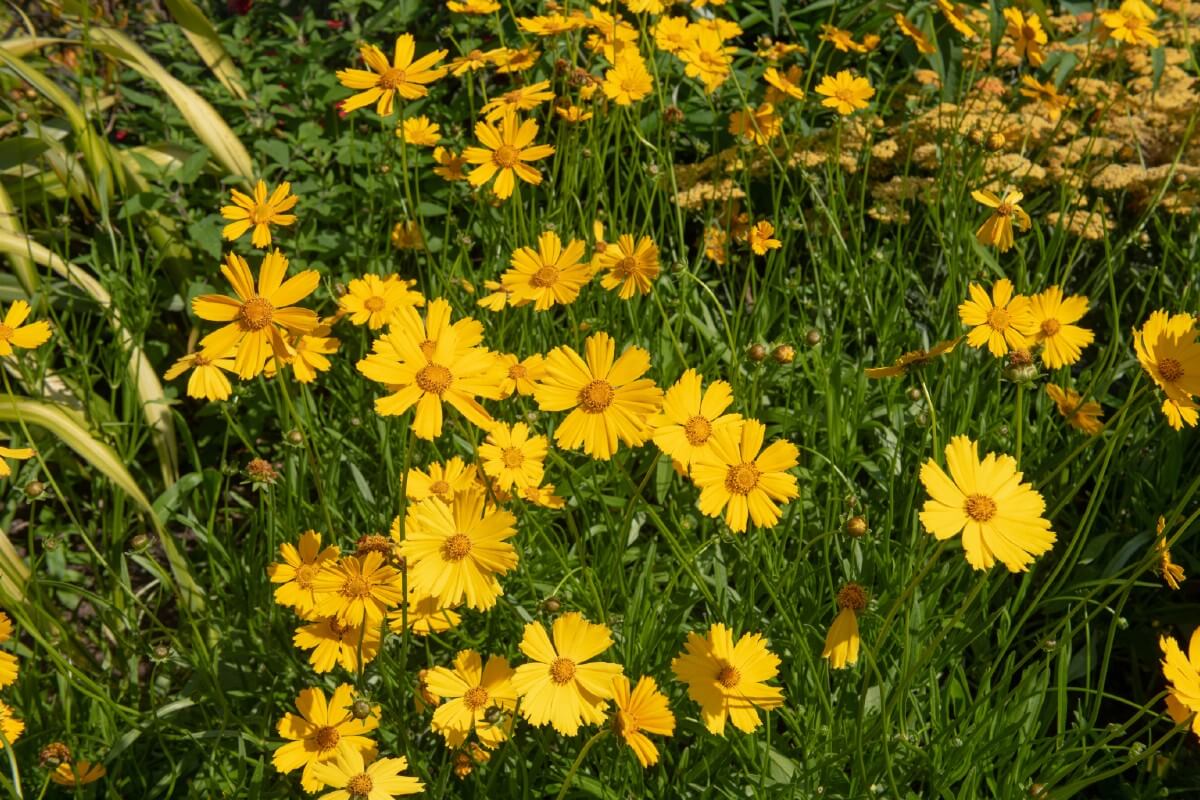
Tickseed is an excellent choice for adding color and appeal to various plantings, particularly wildflower beds, due to its easy-to-grow and low-maintenance nature. This native flower blooms for months, producing large mounding clumps of vibrant colors that attract butterflies and bees. In addition to being unfussy and low-maintenance, Tickseed is a must-have for any wildflower garden and looks stunning when planted in large groups.
Tickseed cultivars that feature orange flowers include Darling Clementine (deep orange), Orange Elf (orange and yellow), Tropical Lemonade (rosy orange), Desert Coral (coral orange and red), Sienna Sunset (apricot-orange), and Mango Punch (peachy orange and red). Depending on the cultivar, Tickseed can be grown in zones 3-10 and is drought-tolerant and resistant to deer.
Another flower that’s worth mentioning is Sneezeweed (Helenium).
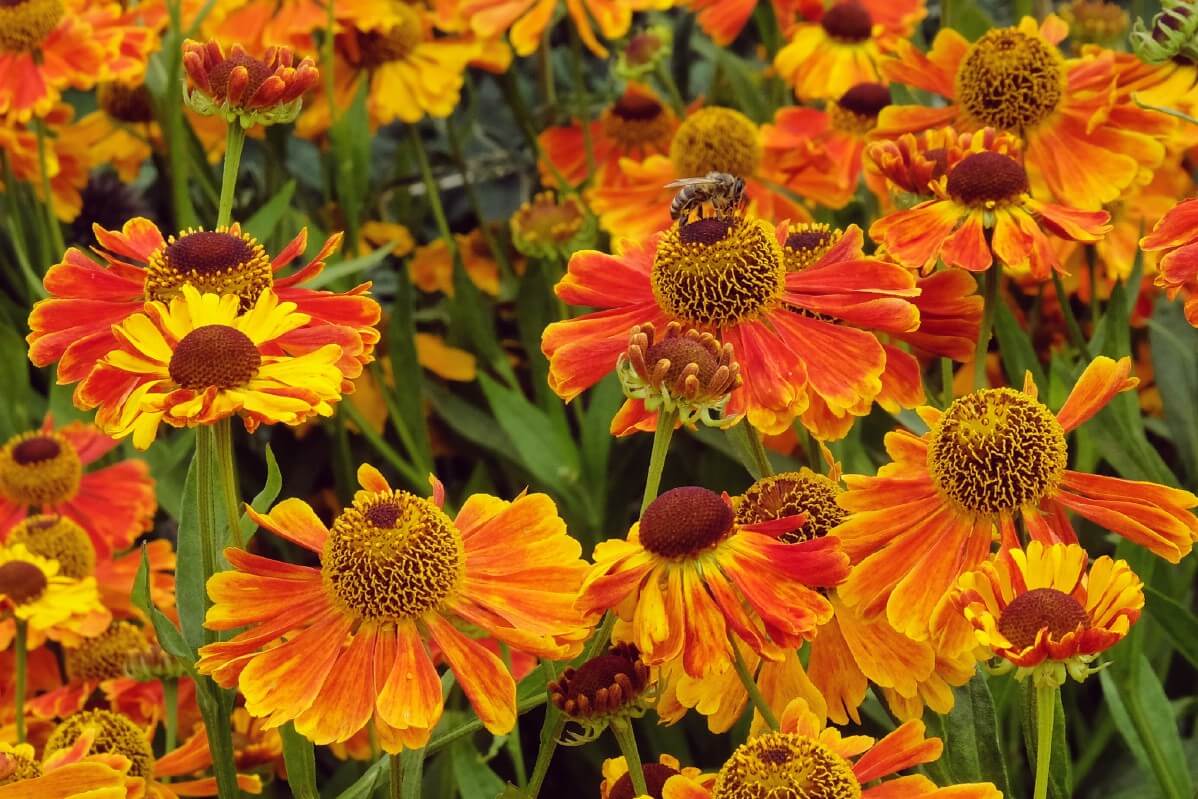
Sneezeweed may have a misleading name, but it’s a beautiful addition to any garden that will keep your bees and butterflies buzzing happily for months. This stunning native perennial features daisy-like flowers that come in an array of vibrant colors. Plus, it’s not a weed! Sneezeweed can grow up to 3-5 feet tall, making it impossible to miss when it’s in full bloom from early summer to fall. You can plant it in small clusters, use it as a border, or even as an edging plant. Another great option for orange-colored flowers is the Tickseed cultivar, which includes varieties like Flammenrad (orange-red), Luc (orange-red), Mardi Gras (orange and yellow bi-color), Sahin’s Early Flowerer (orange-red), Waltraut (copper orange), and Short and Sassy (golden orange). Hardy in zones 3-8 and deer-resistant, these plants thrive in full sun.





